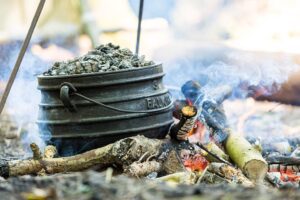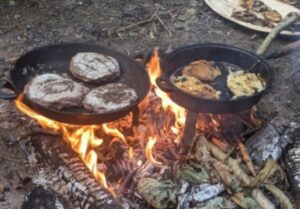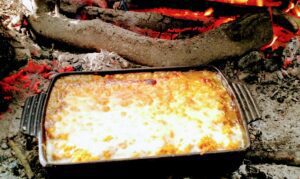Campfire Cooking with Hannah Nicholls

17th November 2022
It has been 20 years since I taught my first fire lesson! I remember it well, I felt so out of my comfort zone. The eyes of the home-ed children and their parents were fixed on me, watching my every move with eager anticipation….keen to watch fire being created before them.
Twenty years on and I cannot remember how many times I have taught fire skills. I have been running Natural Pathways Bushcraft near Canterbury since 2002, not only teaching fire lessons but bushcraft skills and nature awareness to many families, adults and school groups.
I grew up in Suffolk on a small holding. My parents wanted to be as self-sufficient as possible and expected my siblings and I to be hands-on with all the jobs the small holding required; whether that was feeding the chickens, ducks, geese, six cats and one Red Setter, foraging berries, digging for potatoes in the vegetable garden or trying to catch the runaway goats before they devoured all the roses in the back garden. We spent a great deal of time outdoors and some of my fondest memories are of the family relaxing by a fire after a busy day enjoying toasted crumpets and homemade raspberry jam and listening to our parents telling stories.
There’s just something about a fire!
Fire is at the core of our human existence! It provides so many of our basic needs. Warmth, the ability to cook, to boil and purify water. A fire makes a camp whether it’s a cold winter night or a warm summer evening. A camp-fire brings a community together, many a song has been sung and stories told to young and old as they watch the flames flicker and feel the warmth of the fire warming their bodies.

The fire is at the heart of any camp and campfire safety is of utmost importance; only using a safe location for the fire pit, a safe distance from trees or other flammable plants, keeping the fire small and manageable and to have the necessary safety equipment to extinguish a fire and to treat any burns. It’s important that everyone knows good fire etiquette; how to move around the fire area safely or approach a fire safely if placing wood on the fire or cooking.
So, what do we need for lighting a fire? We need a good supply of dry natural tinder, dead seed heads, birch bark, dry leaves to name a few. We need various sizes of kindling, we call the different thickness of the wood, matchstick, pencil and finger thickness. Its best to collect dry, standing dead wood from the base of the trees or where it’s still hanging in the trees. We also need larger wood to keep the fire going and to create a good bed of embers, this is called main fuel. And then ignition; a method of lighting the tinder. This could be matches, lighter, fire steels, flint and steel or even fire by friction. And there are other methods too.
On our camps and foraging days we cook all our meals on the campfire. And do you know that any dish you can cook at home we can cook on the campfire? Be it bread, flatbreads, soups, casseroles, lasagne, shepherds pie, kebabs, pizza, fruit fritters, wild-fruit crumble and even cakes. Many people say to me, you can’t cook a cake on a fire! Oh, can’t you? I reply with a smile.

Cooking Methods
A simple way to cook bread is to twist the dough around a stick and toast it over the hot embers and eat it warm drizzled with honey.
You can use sticks to cook all sorts of things not just sausages and bread, but veg, fish and meat can be cooked on kebab sticks and baked over the embers. Wrapping food in large burdock leaves and placing on the bed of the fire and piling hot embers on top is an excellent way of cooking and is one of my favourite ways to cook fish.
Many things can be cooked straight on the embers, even an egg! Make a hole in the top of the egg and then sit it in the cooler white ash of a fire. It’s important to keep an eye on it and turn it regularly. It should be just like a boiled egg when done.
So I know you are asking, how do you bake a cake on a fire? We need to create an oven! We can do this with a cauldron on Dutch oven. Place the cake batter in a small pan and then sit the pan on top of a few stones (not flint as they explode when heated) inside a Dutch oven or cauldron if on our camps. The stones keep the pan from touching the base of the cauldron and prevents it from burning the base of the cake. The cauldron is then placed on a good bed of embers and hot embers are piled on top of the lid. This is to create the oven effect with heat coming from top and bottom. The cake will bake inside the cauldron just like your oven at home. This method can also be used to bake a loaf of bread.
We love to have a good nutritious meal at the end of the day in the woods and a favourite is Pottage Pie. It’s full of veg and wild edible plants and topped with mashed potatoes and grated cheese and baked in a cast iron pan on embers. A larger pan is placed upside down on top and covered in embers, creating the oven, browning the top and melting the cheese. This method can also be used to cook pizza.

I hope I have wet your appetite and you have enjoyed a little taste of life at Natural Pathways and if you feel inspired you can find out more below.
Popular articles
Walking the Pilgrims Way
Experience the beauty of walking across the Kent Downs NL through the…
Pumpkin Picking in Kent 2024
Get ready for pumpkin picking season and head out with loved ones…
Explore Kent’s Scenic Walks by Train
Discover Kent's hidden gems hassle-free by train, where you can start walking…
